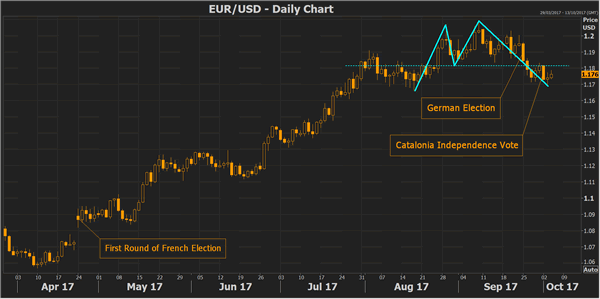The euro has stumbled upon some unexpected headwinds during the past month, taking some of the heat off the currency’s incredible rally this year. Soon after peaking at a 32-month high of $1.2092 on September 8, the euro entered a corrective phase, triggered by a more cautious-than-anticipated European Central Bank at its policy meeting on September 7.
Expectations that the ECB would begin the process of winding down its massive stimulus program, receding political uncertainty after the French elections, as well as the unravelling of the Trumpflation trade have been the main drivers of the euro rally. However, while signalling that policy tightening is forthcoming, the ECB has avoided referring to the tapering discussions as an exit strategy, preferring instead to use words such as "calibration" or "adjustment" of policy. The central bank has also been more careful with its communication, with Governing Council members all signalling a very gradual withdrawal of monetary stimulus in the coming months in a series of public appearances in recent weeks.
Slow progress in achieving a sustained pick-up in underlying inflation in the Eurozone is the main reason why the ECB is dubious about making a hasty exit from its ultra-loose monetary policy program. However, concerns about the euro rising too fast and by too much has also been weighing on policymakers’ minds. Although President Mario Draghi has so far refrained from verbal intervention in talking down the euro, he has expressed concerns about the possible impact of an appreciating exchange rate on growth and inflation. Discomfort about the rising euro is even stronger among the heads of the Eurozone’s periphery central banks.
All of this has led to many analysts readjusting their outlook about ECB policy, with some now predicting the ECB tapering story to become a topic for late 2018 rather than 2017. The euro has retreated by around 3% from its September peak as investors reassess their positions on the single currency. But monetary policy has not been the only factor in inducing the euro’s corrective move lower.
Renewed risks of political instability have remerged to cast doubt about the decline of populist movements across the Eurozone. The inconclusive election outcome in Germany on September 24, which resulted in Chancellor Angela Merkel having to seek coalition partners with smaller parties in potentially protracted negotiations, and this Sunday’s independence vote in the Spanish region of Catalonia, which was declared "unconstitutional" by Spain’s government, have reignited fears of fresh political turmoil in the region.
While Merkel will likely succeed in forming a new coalition, it could make it more difficult for her to join France’s President Emmanuelle Macron in pushing for further EU integration, as one of the prospective coalition partners, the FDP party, is sceptical about closer EU ties. It’s worth noting that markets were pleased with Macron’s win in the French presidential elections in April not only for reducing the political uncertainty but also about the hopes of greater Eurozone integration. Another question that needs to be asked after the elections is how the far right AfD party will shape German politics after winning seats in parliament for the first time.
In Spain, the yes vote in Sunday’s independence referendum could fuel the rise of other separatist movements in Europe, especially in Italy, which is required to hold a general election before May 20, 2018. Italy is seen by many investors as the most vulnerable to a debt crisis. It is also the most at risk of leaving the common currency bloc or even the European Union given the rise of populist parties such as the Five Star Movement, and the separatist Northern League party, who want more autonomy for the northern regions of Italy.
Following these developments, the euro is now in danger of reversing to a downtrend after forming a double top. A key support lies in the $1.1650-1.660 area. A breach of this support level could signal a more bearish outlook in the medium term. The longer-term picture, however, remains very much bullish.

With the ECB expected to eventually pull the plug on its stimulus program, the prospect of a continuation of the current uptrend in euro/dollar is strong. However, the speed and the extent of the uptrend will depend on the ECB’s tolerance level of euro appreciation and developments in the United States.
A rapid rise towards and past the possible ECB pain threshold of $1.25 level could prompt much stronger verbal warnings by policymakers against further appreciation of the currency. Fears by some traders that this threshold is closer to $1.20 contributed to the euro’s pull back from its September high. In addition, further sharp gains could slow the tightening cycle, which the central bank is expected to embark on at its next meeting on October 26.
Meanwhile, progress on the tax reform front in the US, which appears to be gathering more support lately, could revive the Trump-led rally for the US dollar and heighten expectations of further rate hikes by the Federal Reserve. Also potentially fuelling rate rise expectations is the choice of a hawkish nominee to be the next head of the Fed. President Trump is expected to decide in the next few weeks who will replace Fed Chair Janet Yellen when her term expires in February 2018. As Yellen is seen to be a dovish chair, the appointment of a more hawkish candidate could further slow the euro’s ascent over the coming months.











